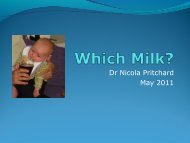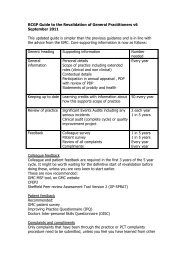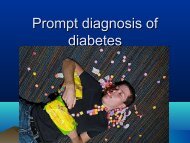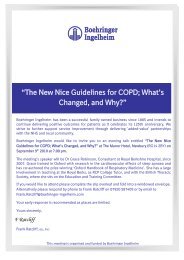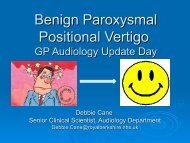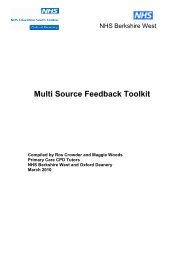Oxfordshire Primary Care Antimicrobial Prescribing Guidelines up ...
Oxfordshire Primary Care Antimicrobial Prescribing Guidelines up ...
Oxfordshire Primary Care Antimicrobial Prescribing Guidelines up ...
You also want an ePaper? Increase the reach of your titles
YUMPU automatically turns print PDFs into web optimized ePapers that Google loves.
OXFORDSHIRE PRESCRIBING GUIDELINES FOR THE USE OF ANTIMICROBIAL AGENTS<br />
FOR PRIMARY CARE 2008<br />
12<br />
ILLNESS COMMENTS DRUG DOSE DURATION OF<br />
TX<br />
Conjunctivitis<br />
Clinical<br />
Knowledge<br />
Summaries<br />
Pneumococcus<br />
Haem.influenzae<br />
Staph.aureus<br />
Chlamydia<br />
(neonates)<br />
Scabies<br />
Sarcoptes scabiei<br />
Clinical<br />
Knowledge<br />
Summaries<br />
Viruses account for over 50% of these<br />
infections.<br />
Most bacterial infections are selflimiting<br />
(64% resolve on placebo A+ ). They<br />
are usually unilateral with yellow-white<br />
mucopurulent discharge.<br />
Fusidic acid has less Gram-negative activity<br />
In neonates Chlamydia may be implicated<br />
which will require systemic erythromycin<br />
12.5mg / kg QDS for 2-3 weeks +/- topical<br />
erythromycin (also treat mother and<br />
partner)<br />
Treat whole body including scalp, face, neck,<br />
ears, under nails.<br />
Treat all household and sexual contacts even<br />
if not showing itching symptoms.<br />
Permethrin: Wash off after 8 – 12 hours<br />
If hands are washed with soap within 8<br />
hours they should be re-treated<br />
chloramphenicol<br />
0.5% drops<br />
fusidic acid 1% gel<br />
permethrin A+<br />
malathion (unlicensed use)<br />
TWO HOURLY<br />
reducing to QDS<br />
BD<br />
5% cream<br />
0.5% Aqueous Liquid<br />
All for 48 hours after<br />
resolution<br />
2 applications as per<br />
BNF instructions one<br />
week apart<br />
2 applications as per<br />
BNF instructions one<br />
week apart<br />
Malation: Wash off after 24 hours<br />
If hands are washed with soap within 24<br />
hours they should be re-treated<br />
Head Lice<br />
Pediculus capitis<br />
Clinical<br />
Knowledge<br />
Summaries<br />
Treatment is not necessary unless a<br />
live louse is found<br />
Offer a choice of treatment strategies: an<br />
insecticide, wet combing, or dimeticone<br />
lotion: No treatment is 100% effective.<br />
Choice of treatment depends on the<br />
preference of the individual/parent and on<br />
the treatment history.<br />
For a woman who is pregnant or<br />
breastfeeding, offer treatment with wet<br />
combing or dimeticone.<br />
Insecticides and dimeticone are not licensed<br />
for children under 6 months except under<br />
medical s<strong>up</strong>ervision<br />
Do not use insecticide lotion more than once<br />
for three consecutive weeks<br />
Consider dimeticone lotion<br />
4% especially if resistance to<br />
insecticides.<br />
If using insecticides use<br />
lotions, not shampoo<br />
Wet combing: Combining<br />
the above or a sole<br />
treatment of regular wet<br />
combing with conditioner<br />
Rub lotion onto dry<br />
hair and scalp. Allow<br />
to remain on for 8<br />
hours or overnight.<br />
Remove by washing<br />
after 8 hours<br />
Rub lotion into dry hair<br />
and allow to dry<br />
naturally.<br />
Remove by washing<br />
after 12 hours<br />
Treatment involves<br />
methodically combing<br />
wet hair with a finetoothed<br />
comb to<br />
remove lice.<br />
This is undertaken for<br />
four sessions over 2<br />
weeks.<br />
Wet combing should<br />
be continued until no<br />
full-grown lice have<br />
been seen for 3<br />
consecutive sessions.<br />
2 applications one<br />
week apart<br />
2 applications one<br />
week apart<br />
Fungal /<br />
Dermatophyte<br />
infection of the<br />
proximal<br />
fingernail or<br />
toenail<br />
For children seek<br />
advice<br />
Take nail clippings: Start therapy only if<br />
infection is confirmed by laboratory.<br />
Idiosyncratic liver reactions occur rarely with<br />
terbinafine.<br />
For infections with yeasts and nondermatophyte<br />
moulds and Candida use<br />
itraconazole. C<br />
Itraconazole can also be used for<br />
dermatophytes<br />
terbinafine A-<br />
itraconazole<br />
250 mg OD<br />
fingernails<br />
toenails<br />
200 mg BD<br />
fingernails<br />
toenails<br />
6 – 12 weeks<br />
3 – 6 months<br />
7 days monthly<br />
2 courses<br />
7 days monthly<br />
3 courses<br />
Please refer to BNF for further information.<br />
APCO Approved January 2008<br />
APCO Approved Amendments; November 2008, March 2009, September 2010<br />
Review Date January 2010<br />
12




